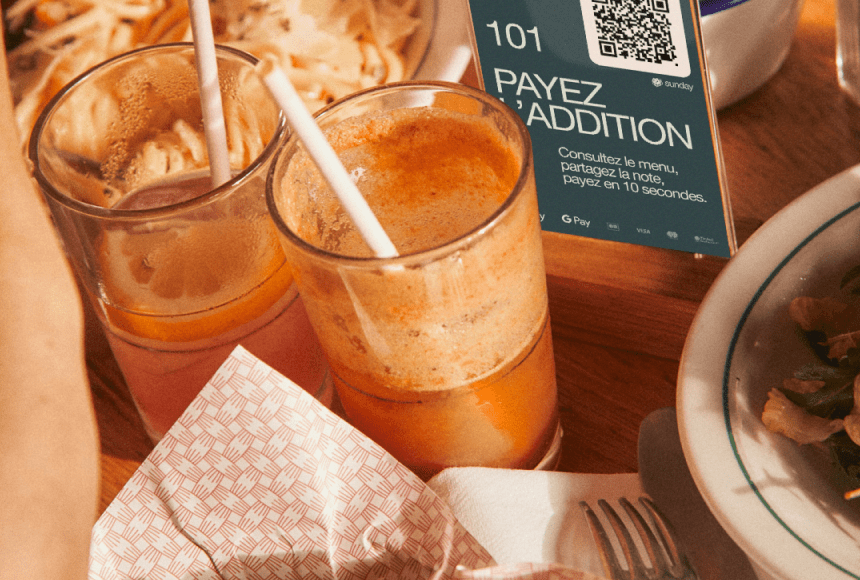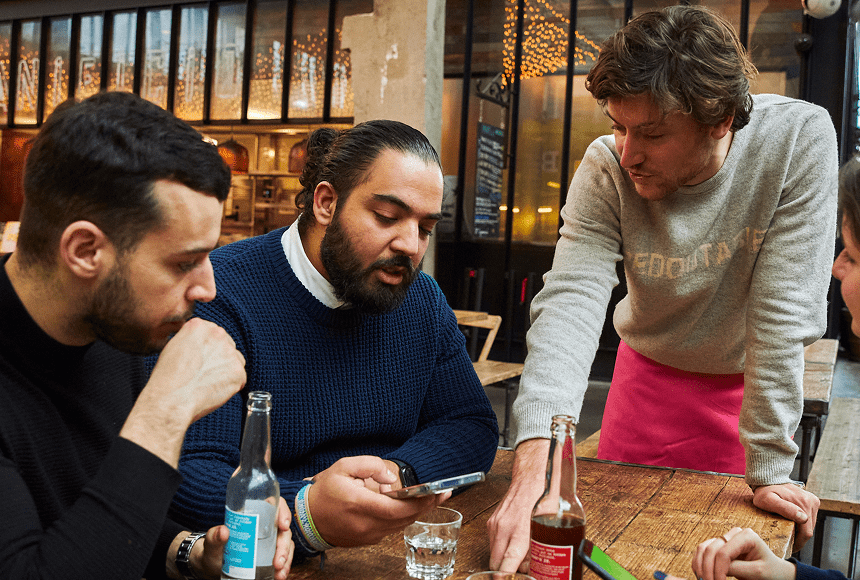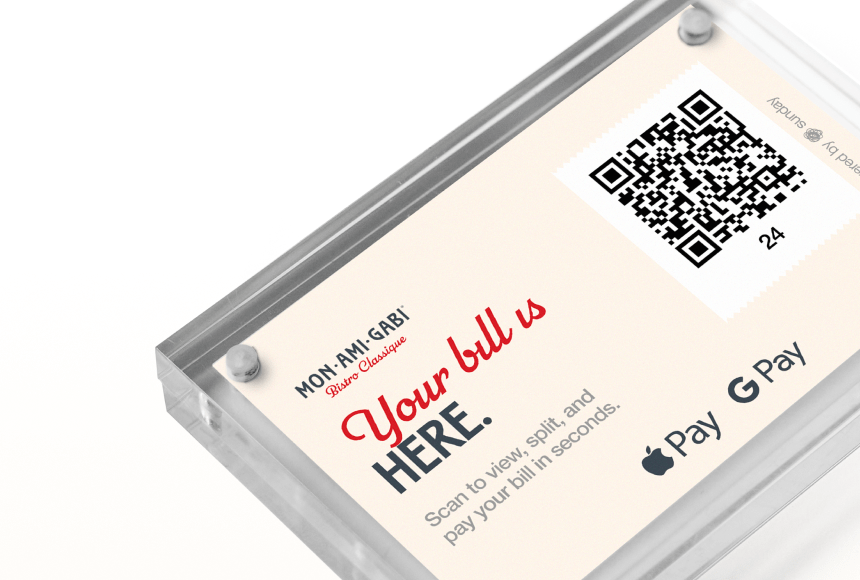
Streamlined Payment for a Stronger Bottom Line
Reimagining the Payment Experience
Picture this: a busy Friday night at your restaurant. Guests crowd in, hungry and anticipating a great meal. The aroma drifting from the kitchen is irresistible. Servers dash between tables, juggling plates of pasta and sizzling steak. With the dining room buzzing, you want every table to turn over efficiently so you can serve as many happy customers as possible. But then the friction begins—everyone is ready to leave, yet they must wait for their checks. Suddenly, your servers are weighed down by credit cards, printing receipts, and waiting on the payment terminal. It slows service, erodes guest patience, and stalls table turnover.
This is where pay-at-table technology comes in. With this innovative system, guests don’t have to wait for the check. Instead, they can quickly and securely settle their bills on their own. That might sound like a minor shift, but it can lead to major benefits for your restaurant’s operations and guest flow.
In the U.S., many restaurants have relied on a traditional system that involves servers walking to and from a payment terminal or handing off card wallets to guests. But as online ordering, QR code menus, and digital loyalty programs continue to rise, it’s become clear that a more seamless payment process is the next natural step. According to the National Restaurant Association, technology is a key driver for efficient workflows in the modern dining environment. Let’s explore how a straightforward, guest-facing payment method can boost table turnover, increase tips, and enhance the overall dining experience.
Why Speed Matters for Turnover and Guest Flow
Here is a fundamental truth about the restaurant industry: quicker table turnover means you serve more guests, which generally translates into higher revenue. Although you never want a guest to feel rushed, you do want to minimize wasted time—especially the downtime between a diner finishing their meal and handing over their payment.
On average, the time between the moment guests ask for the check and the moment they actually depart can be anywhere from 5 to 15 minutes, depending on how busy your servers are. Over the course of a day, those minutes add up, wasting table space and frustrating waiting customers. Meanwhile, your front-of-house teams get stuck delivering checks and processing payments, which distracts them from other critical tasks, like greeting new arrivals, presenting desserts, or managing takeout orders. A pay-at-table system cuts out this back-and-forth.
- Fewer trips for servers: By letting guests handle the check themselves—often via QR code—a server is free for other duties.
- Shorter waiting periods for guests: Guests appreciate having the power to manage their own payment process, with no delays.
- Faster table readiness: Once payment is done, the table can be cleared promptly and set up for the next party.
Faster turnover doesn’t just mean more sales volume—it also enhances the guest experience. Everyone wants to feel in control of their schedule, and with a pay-at-table technology in place, diners choose exactly when to pay and leave. Even a short wait can seem unnecessarily long at the tail end of an otherwise enjoyable meal. Why risk souring a positive experience? A swift, user-friendly checkout process keeps your guests happy and allows you to maintain an optimal flow.
Enhancing the Dining Experience
A key benefit of pay-at-table tech is better guest autonomy. At times, even the most attentive server can be sidetracked if multiple tables request the check simultaneously. With a direct payment method, no one is left waiting or wondering if they’ll catch the server’s eye. Guests simply tap or scan, review their bill, and pay when they’re ready.
Additionally, because the checkout is frictionless, diners may be more inclined to leave higher tips. Think of it like providing a pleasant finishing touch to their meal. By removing the stress that often comes at the end of the dining experience, you create a positive impression that can translate into better feedback and online reviews. In fact, services like sunday integrate functionalities that encourage diners to leave real-time feedback, including online reviews. Even a quick prompt—“Enjoyed your meal? Share your thoughts!”—can increase your visibility and strengthen your reputation.
Many pay-at-table platforms also allow easy splitting of the bill. Anyone who has dined in a large group knows how time-consuming it can be for the server to figure out who owes what. That process can involve multiple trips to your payment terminal, more opportunities for error, and less time for the server to attend to other tables. By empowering diners to split the tab themselves, you eliminate complicated calculations and ensure a more accurate, stress-free experience for everyone involved.
A Day in the Life: How It Works
Let’s walk through a typical scenario of pay-at-table technology in action. Imagine your restaurant is called “Bella’s Bistro.” On a typical Saturday night:
- Warm Welcome: Guests arrive, your host seats them, and hands out the menus (either physical or digital tablets, if you like modern flair). The server does their usual routine—introducing specials, taking drink orders—no big change there.
- Seamless Service: Throughout their meal, your guests simply enjoy their dining experience. They might ask questions about the menu or place additional orders. Nothing feels rushed or forced.
- Ready to Pay: When everyone finishes dessert, instead of requesting the check, they scan a QR code at the table using their phone. Right away, they see their total, tip options, and a button to pay with whichever card or app they prefer.
- Instant Settlement: Payment confirmation arrives on their phones. If your system includes integrated tipping tools, guests can easily leave extra gratuity. No calculators, no chasing down a server—just a few taps, and it’s done.
- Quick Flip: As soon as guests step away, your bussers clean and re-set the table. A new party is seated promptly, and your server can devote attention to them without a lag.
This improved dynamic doesn’t just help speed. It preserves a sense of hospitality and personal interaction. Your staff is still present, greeting and guiding guests, but they’re freed from the time-consuming check routine. Now, servers can focus on quality interactions—explaining dishes, making wine recommendations, or managing dietary needs—instead of rushing to run credit cards. In the end, you preserve the charm of personal service without letting logistics slow you down.
From Busy Weeknights to Special Events
Restaurants aren’t all about night-time dining. Between lunch rushes and weekend brunch, many operations handle constant flows of people throughout the day. By implementing pay-at-table technology, you’re set up to handle these variations smoothly.
Consider a quick-service lunch scenario where diners are on tight breaks. They’ll appreciate not having to track down a server for the check. Instead of anxiously glancing at the clock, they can finalize payment and leave at their own pace. Meanwhile, you can turn tables faster and serve the next wave of hungry workers. It’s a win-win.
For bigger gatherings like catered events or banquets, pay-at-table doesn’t always feel like an obvious match. However, it can still work wonders in certain group dining setups. If you’re hosting a large party with customized orders, think of the headache that final tab can cause. Eliminating guesswork by letting diners individually pay for their share can save staff a lot of time and confusion. Not every event needs to operate this way, but having the option keeps your restaurant agile and equipped to handle any scenario.
Real Data for Your Decisions
Sometimes, the proof is in the numbers. While every restaurant is unique, various industry reports underscore the positive impact of pay-at-table tools on the bottom line. According to Restaurant Dive, technology solutions that streamline payment can cut wait times by up to 30%. When you apply that reduction across multiple shifts and numerous tables, the revenue boost becomes substantial.
Furthermore, fewer errors in payment processing can also save costs. Manual entry mistakes, lost receipts, or misapplied promotions can chip away at your profit margins over time. Automating and digitizing the payment system reduces those risks. The immediate visibility of the check—on the customer’s device—also invites transparency. Guests can see if everything is correct, which fosters trust and reduces the likelihood of disputes or returns after the fact.
There’s also a morale factor to consider. When staff is relieved of repetitive tasks, they perceive the day-to-day workflow as more manageable. Lower stress levels might reduce turnover among your best employees. That stability can translate into substantial long-term savings, since hiring and training new servers can cost thousands of dollars each time. A more engaged, less stressed team can directly affect your restaurant’s reputation and, ultimately, its profit.
Empowering Your Team
It’s natural for restaurant owners to wonder how their team members will respond to such technology. Will staff feel that personal touch is missing? In reality, many servers find that pay-at-table technology frees them to cultivate a more personalized connection with guests.
- Proactive problem-solving: With less time spent running receipts, servers can address issues early—such as a delayed entrée or a wine pairing question.
- Increased sales focus: With the end-of-meal payment routine streamlined, servers can focus on upselling beverages, desserts, or extras that enhance the guest experience.
- Better team collaboration: Because servers and bussers spend less time on repetitive duties, they can work together more effectively to maintain a welcoming ambiance, greet new arrivals, and manage cleanliness.
Plus, tips often go up. Why? Because an easy payment flow—especially if it includes suggested tip percentages—encourages diners to express gratitude for exceptional service. While some might say a digital prompt is impersonal, it often results in higher voluntary tipping, particularly when it follows excellent hospitality.
Comparing New vs. Old Systems
| Aspect | Traditional Payment | Pay-at-Table Technology |
|---|---|---|
| Time to Pay | 5–15 minutes (or more) after final request | 1–5 minutes, immediate card processing |
| Server Workload | High (back and forth to the payment terminal) | Lower, more time for guest service |
| Error Risk | Higher (manual receipt entries) | Lower, automated billing summary |
| Guest Satisfaction | Variable (some find it slow) | Generally higher (fast, no waiting) |
Upgrading to a pay-at-table solution does require a period of training and adjustment, but the potential gains often outweigh the learning curve. Once your staff becomes accustomed to the new workflow, both servers and diners typically see the advantages.
Implementing Pay-at-Table: Key Considerations
If you’re convinced about the benefits, here are a few considerations to set you on the right path:
- Hardware vs. Software: Some solutions require specialized devices; others work purely with QR codes that diners scan with their own phones. Decide which approach aligns best with your brand and clientele.
- Seamless Integration: Ensure that the pay-at-table option syncs well with your point-of-sale (POS) or inventory management system. This will avoid data discrepancies or double entry.
- Staff Training: Teach your servers to guide customers through the process confidently. Clear, friendly explanations can turn first-time users into raving fans.
- Guest Education: Display prompts on your menu or table explaining how to pay. Encourage staff to mention it when greeting guests or delivering the first round of drinks.
- Security Measures: Always verify that the technology partner complies with industry standards like PCI DSS to protect sensitive cardholder data.
Solutions like sunday have already done much of the heavy lifting by creating a simple checkout flow that is PCI-compliant, intuitive, and fast. Many U.S. restaurants have witnessed an immediate rise in table turnover and a drop in processing friction once implementing a streamlined pay-at-table approach.
Looking Ahead: The Future of Table Service
Restaurants are evolving. With more diners craving convenience, an environment that supports quick, seamless payments can be a game-changer. But this evolution doesn’t stop with payment. As more technologies converge—like in-house Wi-Fi, digital loyalty programs, and automated marketing tools—restaurants can craft a fully connected experience. That means analyzing order data in real-time, customizing promotions for returning customers, and further reducing friction at all stages of the meal.
Pay-at-table technology sits at the heart of this shift, because it’s the point where the value of a great dining experience ideally intersects with modern efficiency. You don’t sacrifice the personal touch that keeps guests coming back, but you adapt your operations to modern expectations. Implementation can be phased to fit your budget and your team’s readiness. Start with a few tables or a single section, gauge the response, and roll it out to your entire dining room when you’re confident in the results.
Elevate Your Venue with Effortless Payments
Ultimately, pay-at-table technology can be your secret ingredient in the competitive restaurant business. You create a faster, more efficient flow without losing the warm service that sets your establishment apart. By speeding up the final step of the dining experience, you open the door for higher table turnover, improved guest satisfaction, and even bigger tips for your hardworking staff.
It’s time to see payment not as an afterthought but as an integral part of your restaurant’s success. Think of it this way: every guest wants to leave on a high note. Make that last moment memorable for the right reasons—because it was smooth, clear, and incredibly simple. Once you’ve mastered that, you can turn your attention to the finer details: refining your menu, engaging your community, and crafting those unforgettable flavors that keep guests coming back for more.
Find out more today
Drop us your details below and we’ll reach out within the next 24h
“Check please” is a thing of the past.
With our integrated QR codes your customers pay in seconds, straight from their table.



